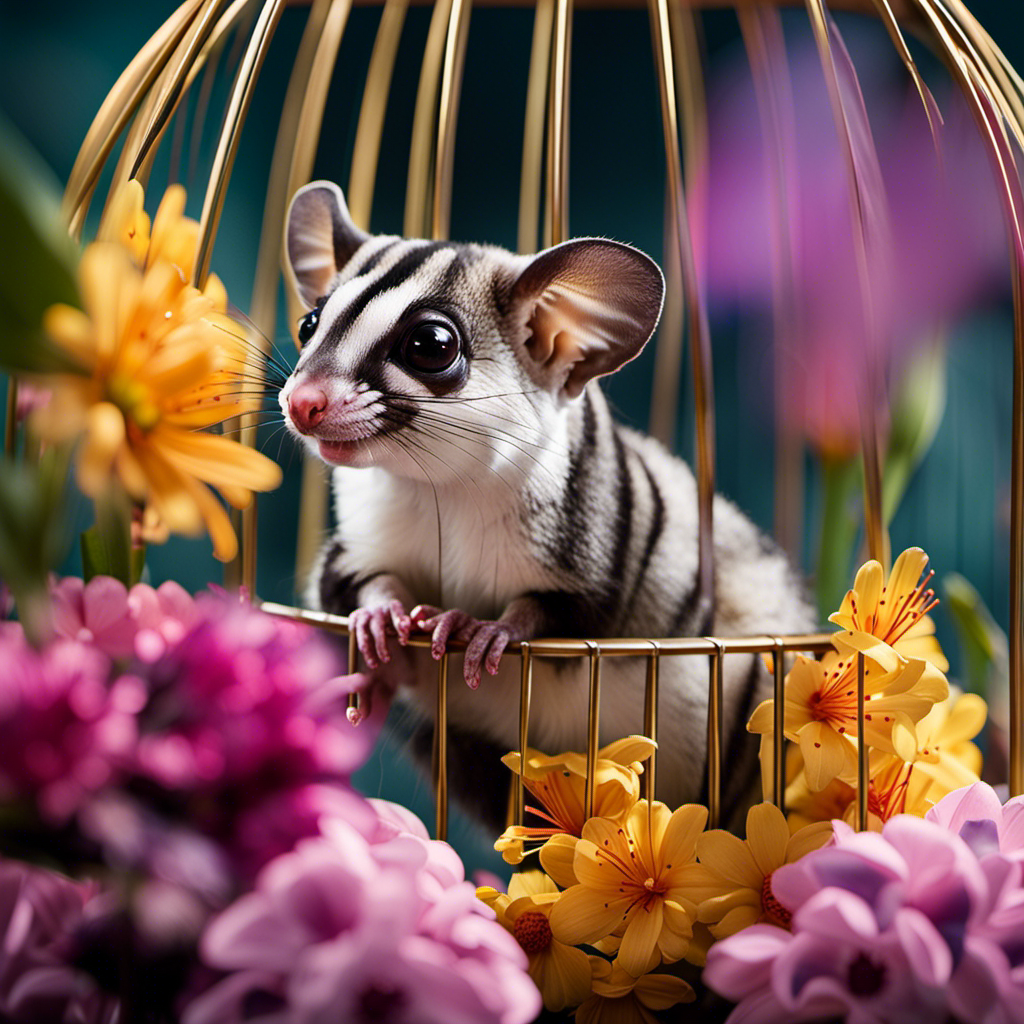I’ve always been curious about whether sugar gliders as pets have any scent.
Well, in this article, we’ll dive into the fascinating biology of sugar gliders and explore the various factors that can contribute to their odor.
We’ll discuss the role of diet and nutrition, the importance of hygiene and cage cleaning, as well as how stress and health issues can affect their scent.
By understanding these factors, we can better weigh the pros and cons of owning a sugar glider and make an informed decision.
So, let’s uncover the truth about sugar glider odor together.
Key Takeaways
- Odor in pet sugar gliders is primarily caused by bacteria on their skin and in their feces.
- Regular cage cleaning, hygiene maintenance, and proper ventilation help minimize odor.
- Sugar gliders have specific dietary needs that should include a variety of fruits, vegetables, proteins, and supplements.
- Consulting a veterinarian specializing in exotic animals is recommended for expert guidance on reducing odor and maintaining a healthy living environment.
Understanding Sugar Glider Biology
Sugar gliders have a unique biology that sets them apart from other pets. Understanding their behavior and communication can help us better care for them.
Sugar gliders are social animals and thrive in groups or pairs. They have a complex social structure and rely on various forms of communication to interact with each other.
Vocalizations, such as barking and chirping, are used for territorial disputes and to attract mates. Scent marking is another important aspect of their communication. They have scent glands located on their forehead and chest, which they use to mark their territory and communicate with other sugar gliders.
This biology plays a significant role in their overall behavior and can contribute to the odor they may produce.
Factors that Can Contribute to Odor
Factors such as diet and hygiene can impact the odor of pet sugar gliders. It is important to understand that sugar gliders have a unique scent due to their natural biology. The odor is primarily caused by bacteria that live on their skin and in their feces. These bacteria produce volatile compounds that give off a distinct smell.
To minimize the odor, it is crucial to maintain proper hygiene by cleaning the glider’s cage regularly and providing them with a clean environment. Additionally, proper ventilation is essential as it helps to circulate fresh air and reduce the buildup of odorous compounds.
By understanding the role of odor-causing bacteria and ensuring proper ventilation, we can effectively manage the scent of pet sugar gliders.
Moving on to diet and nutrition, it is important to consider their specific dietary needs.
Diet and Nutrition
To maintain a healthy diet for your furry companion, it’s crucial to provide them with a balanced and nutritious meal plan. When it comes to sugar gliders, their diet plays a vital role in keeping them happy and healthy.
Sugar gliders have specific nutritional needs that must be met to ensure their well-being. Their diet should consist of a variety of fruits, vegetables, proteins, and supplements. Fruits like apples, grapes, and bananas are excellent choices, while vegetables such as carrots and leafy greens provide essential vitamins. Proteins like mealworms or cooked chicken are necessary for their growth and development. Additionally, calcium and vitamin supplements are crucial to maintaining their overall health.
By providing a well-rounded diet, you can ensure your sugar glider receives the necessary nutrients to thrive.
Now let’s dive into the importance of hygiene and cage cleaning.
Hygiene and Cage Cleaning
Keeping up with regular cage cleaning is essential for maintaining the hygiene and cleanliness of your sugar glider’s living space. Understanding odor causing bacteria is crucial in tackling any unpleasant smells that may arise.
Sugar gliders have scent glands, and if their cages are not cleaned regularly, bacteria can thrive and produce odors. To combat this, it is important to choose the best cleaning products for sugar glider cages. Look for pet-safe, non-toxic cleaners that effectively eliminate bacteria and odor. Some recommended options include vinegar and water solutions or pet-specific cage cleaners.
Maintaining a clean cage not only helps prevent odor but also promotes the health and well-being of your sugar glider. By keeping their living space clean, you can minimize the risk of stress and health issues.
Stress and Health Issues
By ensuring a clean living environment for your furry friend, you can help minimize the risk of stress and potential health issues.
Stress management is crucial for the well-being of your pet sugar glider, as excessive stress can lead to various health problems. These adorable creatures are highly sensitive and can easily become stressed by changes in their environment or routine.
Maintaining a clean cage, providing regular exercise, and offering a balanced diet are all important factors in reducing stress levels. Not only does stress management improve your sugar glider’s overall health, but it also contributes to their overall happiness and well-being.
Now, let’s move on to some helpful tips for reducing sugar glider odor and keeping their living space fresh and pleasant.
Tips for Reducing Sugar Glider Odor
Now that we have discussed the impact of stress and health issues on the odor of pet sugar gliders, let’s move on to some practical tips for reducing their smell.
As a sugar glider owner, I understand the importance of odor management to maintain a pleasant living environment. One effective way to reduce odor is by regularly cleaning their cage and accessories. This includes removing waste, replacing bedding, and washing their toys and dishes.
Additionally, proper ventilation is crucial to prevent the buildup of odor. Ensuring that their living space is well-ventilated will help to minimize any lingering smells.
Another helpful tip is to incorporate natural odor neutralizers, such as baking soda or activated charcoal, in their cage. These substances can absorb and reduce unpleasant odors.
By implementing these practices, you can effectively manage and reduce the odor associated with pet sugar gliders.
Speaking of maintaining a healthy living environment, let’s now explore the importance of proper diet and nutrition.
Proper Diet and Nutrition
One effective way to ensure a healthy living environment for your furry friends is by providing them with a proper diet and nutrition. Sugar gliders have specific dietary restrictions that need to be taken into consideration. Here are four important factors to keep in mind when it comes to their nutrition:
-
Balanced Diet: A balanced diet is crucial for the overall well-being of sugar gliders. It should consist of a variety of fruits, vegetables, proteins, and supplements to meet their nutritional needs.
-
Limited Sugary Foods: Sugar gliders have a high sensitivity to sugar, so it is important to avoid feeding them sugary treats and processed foods. These can lead to health issues such as dental problems and obesity.
-
Calcium and Vitamin D: Sugar gliders require adequate calcium and vitamin D for strong bones and teeth. Incorporating calcium-rich foods like leafy greens and providing them with proper exposure to natural sunlight or UVB lighting is essential.
-
Consult a Veterinarian: It’s always a good idea to consult a veterinarian who specializes in exotic animals to ensure that you are providing the best diet for your sugar glider. They can provide expert guidance and recommend specific dietary plans based on your pet’s individual needs.
By following these dietary guidelines, you can help ensure that your sugar glider stays healthy and happy.
Now, let’s move on to the next important aspect of maintaining a clean living environment for them – regular cage cleaning.
Regular Cage Cleaning
To keep your sugar glider’s cage clean and odor-free, make sure you regularly clean their bedding and remove any waste.
Understanding the sources of odor is key to implementing an effective cleaning routine. Sugar gliders have scent glands that produce a musky smell, especially in unneutered males. Additionally, their waste, such as urine and feces, can contribute to the overall odor of their cage.
To combat these smells, it is important to clean the cage at least once a week, removing any soiled bedding and wiping down surfaces with a pet-safe cleaner. This will help eliminate any lingering odor and prevent bacterial growth.
Providing a Clean and Comfortable Environment
Make sure you clean the cage regularly to provide a comfortable and odor-free environment for your furry friend. Cleaning techniques and odor control are essential to keep your pet sugar glider happy and healthy.
Here are three important steps to follow:
-
Remove waste daily: Sugar gliders are small animals with a fast metabolism, which means they produce waste frequently. Scoop out any solid waste and soiled bedding every day to prevent odor buildup.
-
Change bedding weekly: Sugar gliders love to burrow and nest in their bedding. Replace the bedding once a week to maintain cleanliness and freshness. Choose bedding made from materials like paper or wood shavings that are safe for your glider.
-
Wipe down surfaces: Regularly clean the cage bars, platforms, and toys with a mild pet-safe cleaner. This will help eliminate any bacteria or odor-causing substances.
By following these cleaning techniques and maintaining good odor control, you can create a clean and comfortable environment for your pet sugar glider.
Now, let’s move on to bathing and grooming techniques without further ado.
Bathing and Grooming Techniques
Regularly bathing and grooming your furry friend helps to keep them clean and healthy. When it comes to bathing techniques for sugar gliders, it’s important to be gentle and use natural grooming methods.
These small creatures have delicate skin and can easily become stressed, so it’s crucial to handle them with care. To ensure a pleasant bathing experience, I recommend using lukewarm water and mild, fragrance-free shampoo specifically made for sugar gliders. Avoid getting water in their ears or eyes, as this can cause discomfort. Additionally, make sure to dry them gently with a soft towel afterwards to prevent any chill.
By following these gentle bathing techniques and using natural grooming methods, you can keep your sugar glider clean and happy without causing them any unnecessary stress or harm.
In the next section, we will explore some effective gentle bathing methods.
Gentle Bathing Methods
When bathing your furry friend, remember to use gentle techniques that won’t cause them unnecessary stress or discomfort. Here are some tips to ensure a gentle bathing experience for your pet sugar glider:
- Use lukewarm water to avoid shocking their sensitive skin.
- Opt for a mild, fragrance-free shampoo specifically formulated for small animals.
- Gently massage the shampoo into their fur, being careful not to tangle or pull.
- Rinse thoroughly to remove all traces of shampoo.
- Pat dry with a soft towel or use a hairdryer on the lowest setting, keeping a safe distance.
By following these gentle bathing methods, you can reduce odor and keep your pet sugar glider clean and comfortable.
Now, let’s move on to the next important aspect of grooming: brushing and trimming their fur.
Brushing and Trimming Fur
To keep your furry friend’s fur looking neat and tidy, it’s important to brush and trim it regularly. Brushing techniques and trimming methods play a vital role in maintaining a healthy and attractive coat for your pet sugar glider. Here are some effective techniques and methods to ensure your sugar glider’s fur is in top shape:
| Brushing Techniques | Trimming Methods | Grooming Tools |
|---|---|---|
| Gentle brushing in the direction of hair growth | Use rounded-tip scissors for safety | Slicker brush for removing tangles |
| Regularly check for mats or knots and gently detangle | Trim long hairs around the ears and paws | Fine-toothed comb for precision |
| Avoid excessive pulling or tugging | Trim nails to prevent scratching | Nail clippers for trimming nails |
Using Odor-Neutralizing Products
Using odor-neutralizing products is a great way to keep your furry friend smelling fresh and clean. When it comes to odor neutralizing products for pets, there are a variety of options available.
One popular choice is using natural alternatives, such as vinegar or baking soda. These natural substances help to absorb and eliminate odors without any harsh chemicals.
Additionally, there are many commercially available pet-specific odor neutralizing sprays and powders that are designed to target and eliminate pet odors. These products often contain enzymes that break down the odor-causing molecules, leaving your pet’s coat smelling fresh. It’s important to follow the instructions provided with these products to ensure safe and effective use.
Now, let’s move on to scent-masking techniques that can further help keep your pet’s scent at bay.
Scent-Masking Techniques
Another effective way to mask any lingering scents is by incorporating scented candles or air fresheners into your home. Here are some natural odor control techniques you can try:
- Essential oils: Choose scents like lavender, eucalyptus, or lemon that have deodorizing properties and can help mask any unpleasant smells.
- Baking soda: Sprinkle baking soda on carpets, furniture, or bedding and vacuum it up after a few hours to absorb odors.
- Vinegar solution: Mix equal parts of water and white vinegar in a spray bottle and use it to wipe down surfaces or spray it in the air to neutralize smells.
- Fresh flowers or herbs: Place bouquets of fragrant flowers or herbs around your home to add a natural and pleasant aroma.
By incorporating these scent masking techniques, you can effectively control the odor in your home.
Now, let’s move on to using odor-neutralizing sprays to further tackle any lingering scents.
Using Odor-Neutralizing Sprays
You can easily eliminate lingering odors by using odor-neutralizing sprays throughout your home.
When it comes to odor control, natural remedies are often the best option. Odor-neutralizing sprays work by neutralizing the molecules responsible for the unpleasant smell, rather than just masking them with a stronger scent.
These sprays are designed to tackle a wide range of odors, from pet smells to cooking odors and more. They are easy to use and can be sprayed directly on surfaces, fabrics, and even in the air. Not only do they eliminate odors, but they also leave a fresh and clean scent behind.
Incorporating natural aromatics into your odor-control routine is another effective way to freshen up your home without using harsh chemicals or artificial fragrances.
Incorporating Natural Aromatics
To freshen up the scent of your home, consider incorporating natural aromatics into your routine. Natural scent masking techniques, such as incorporating essential oils, can help neutralize odors and create a more pleasant environment.
Essential oils like lavender, eucalyptus, and lemon have natural deodorizing properties that can help eliminate pet odors. Simply add a few drops to a diffuser or mix with water in a spray bottle to create a homemade air freshener. These natural aromatics not only mask unpleasant smells but also provide a calming and refreshing atmosphere.
However, it’s important to be mindful of the potency of essential oils and use them in moderation to avoid overwhelming your space. By incorporating natural aromatics, you can effectively combat pet odors and create a more inviting home environment.
To further enhance the freshness of your home, proper ventilation and air circulation are also essential.
Proper Ventilation and Air Circulation
Proper ventilation and air circulation are key to maintaining a fresh and inviting home environment. Here are three important factors to consider for improving ventilation and air quality in your home:
-
Install exhaust fans: These are essential in areas such as the kitchen and bathroom, where moisture and odors tend to accumulate. Exhaust fans help remove stale air and promote better air circulation.
-
Open windows and doors: Whenever possible, open up your windows and doors to allow fresh air to flow through your home. This helps reduce indoor air pollution and brings in natural ventilation.
-
Use air purifiers: Consider investing in air purifiers to improve the air quality in your home. These devices help filter out allergens, dust, and other pollutants, ensuring that the air you breathe is clean and fresh.
By implementing these strategies, you can significantly improve the ventilation and air quality in your home, creating a healthier and more comfortable living space for you and your pets.
Speaking of pets, regular veterinary check-ups are essential for their well-being, ensuring they stay healthy and happy.
Regular Veterinary Check-Ups
Regular veterinary check-ups are necessary to ensure the health and well-being of your furry companions. When it comes to sugar gliders, these check-ups are especially important in maintaining their overall health and addressing any potential issues that may contribute to odor.
During these check-ups, veterinarians can not only examine your sugar glider’s physical health but also provide guidance on understanding grooming techniques specific to their needs. Regular check-ups allow veterinarians to monitor your sugar glider’s weight, dental health, and overall wellness. They can also identify and address any underlying health issues that may be causing odor, such as dental infections or gastrointestinal problems.
Addressing Health Issues that may Contribute to Odor
Transition: Now that we understand the importance of regular veterinary check-ups for our pet sugar gliders, let’s dive into addressing health issues that may contribute to odor.
Current Subtopic: Addressing Health Issues that may Contribute to Odor
As responsible pet owners, it is crucial to be proactive in identifying and resolving any health issues that our furry friends may experience. By doing so, we not only ensure their well-being but also tackle any odor concerns that may arise. To help you navigate this, here is a table outlining common health issues that can contribute to odor and the corresponding actions you can take to address them effectively.
| Health Issue | Action to Address Odor |
|---|---|
| Urinary Tract Infections | Provide a proper diet and encourage hydration |
| Dental Problems | Regularly brush their teeth and offer dental treats |
| Digestive Issues | Feed a balanced diet and incorporate probiotics |
| Skin Infections | Maintain proper hygiene and consult a veterinarian |
| Ear Infections | Clean ears regularly and seek veterinary care |
Ensuring Proper Nutrition and Hydration
To keep your furry friends healthy and odor-free, it’s important to prioritize their nutrition and hydration needs. Here are four key ways to ensure proper hydration and a balanced diet for your pets:
-
Provide fresh water: Make sure your sugar glider always has access to clean drinking water. Change it daily to prevent bacteria growth.
-
Offer a varied diet: Sugar gliders need a mix of fruits, vegetables, proteins, and supplements. Consult with a veterinarian to create a balanced meal plan.
-
Avoid sugary treats: While sugar gliders love sweet treats, excessive sugar can lead to health issues. Stick to natural, low-sugar options like fresh fruits and vegetables.
-
Monitor portion sizes: Overfeeding can lead to obesity and health problems. Follow recommended portion sizes to maintain a healthy weight for your sugar glider.
By ensuring proper hydration and a balanced diet, you can help your sugar glider stay healthy and minimize any potential odor concerns.
Now, let’s move on to the next section about bonding and socialization.
Bonding and Socialization
When bonding with your furry friend, it’s important to spend quality time together to build trust and create a strong bond. Establishing trust is crucial for a healthy relationship with your pet sugar glider.
One way to do this is by engaging in activities that provide mental stimulation. Sugar gliders are highly intelligent creatures that require mental stimulation to thrive. You can achieve this by offering puzzle toys, hiding treats, or teaching them tricks. By engaging their minds, you are not only providing entertainment but also creating opportunities for trust to develop.
As your sugar glider begins to trust you more, they will feel more secure and comfortable in your presence. This will lay the foundation for establishing a trusting relationship based on mutual understanding and companionship.
Establishing a Trusting Relationship
Building trust with your furry friend is essential for a strong and healthy relationship. When it comes to establishing trust with your pet sugar glider, patience and consistency are key. These small marsupials are naturally cautious creatures, so it’s important to build rapport slowly and gently. To help you on your journey, I have created a table below with three effective strategies for building trust with your sugar glider:
| Strategies for Establishing Trust |
|---|
| 1. Spend quality time together |
| 2. Offer treats as rewards |
| 3. Respect their personal space |
Encouraging Exercise and Playtime
Make sure you set aside dedicated time each day for playing and exercising with your furry friend. Exercise benefits are not only important for maintaining your pet’s physical health, but they also play a crucial role in their mental well-being.
Engaging in playtime activities and exercise not only helps to keep your pet physically fit, but it also provides mental stimulation and helps prevent boredom. Interactive play sessions, such as using toys or engaging in games, can help strengthen the bond between you and your pet while also providing them with the mental stimulation they need.
Providing Mental Stimulation
To keep your furry friend mentally stimulated, try incorporating puzzle toys into their daily routine. Mental stimulation is crucial for the overall well-being of animals, including our beloved pets. It helps to keep their minds active, prevents boredom, and encourages problem-solving skills.
Puzzle toys are a great way to engage your pet’s cognitive abilities and provide them with a fun challenge. These toys usually involve hiding treats or toys inside compartments that your pet has to figure out how to access. Not only does this keep them entertained, but it also provides numerous benefits such as reducing anxiety, preventing destructive behavior, and improving their overall mental health.
By incorporating mental stimulation techniques into your pet’s routine, you are helping them lead a happier and healthier life.
Speaking of routines, let’s discuss the importance of proper waste management for your pet.
Proper Waste Management
Now that we have discussed the importance of providing mental stimulation for pet sugar gliders, it is crucial to address another aspect of their care: proper waste management.
As with any pet, sugar gliders produce waste that needs to be dealt with effectively. There are several waste disposal methods that can be employed to maintain a clean and hygienic environment for both you and your gliders.
One popular method is using litter trays or pans filled with a suitable bedding material to collect their waste. Additionally, incorporating odor control techniques such as using pet-safe deodorizers or regularly cleaning the waste areas can help minimize any unpleasant smells associated with their waste.
By implementing these waste disposal methods and odor control techniques, you can ensure a pleasant living environment for both yourself and your pet sugar gliders.
Speaking of cleanliness, let’s now move on to the importance of regularly cleaning waste areas.
Regularly Cleaning Waste Areas
Regularly cleaning the waste areas is crucial to maintaining a hygienic living environment for both you and your pet sugar gliders. To ensure cleanliness, it is important to follow regular cleaning techniques.
Start by removing any solid waste daily and spot clean any soiled areas with a mild pet-safe cleaner. Once a week, thoroughly clean the entire cage, including the bars, platforms, and toys, using a pet-safe disinfectant.
Additionally, using odor control products can help minimize any unpleasant smells. There are various options available, such as pet-safe sprays or powders that can be applied to the waste areas. These products help neutralize odors and keep the cage smelling fresh.
By regularly cleaning and using odor control products, you can provide a clean and odor-free environment for your pet sugar gliders.
Speaking of maintaining a clean living space, using appropriate litter and bedding is essential.
Using Appropriate Litter and Bedding
Using the correct litter and bedding is vital for creating a comfortable and safe environment for your pet sugar gliders. Choosing the right materials not only promotes their well-being but also helps control odor effectively. Here are some important points to consider when selecting bedding for your sugar gliders:
- Opt for bedding made from natural materials like wood shavings or recycled paper to ensure it is safe for your pets.
- Avoid using cedar or pine shavings as they can release harmful chemicals and irritate their sensitive respiratory systems.
- Consider using bedding with odor control properties, such as activated carbon or baking soda, to keep unpleasant smells at bay.
- Regularly replace soiled bedding to maintain a fresh and hygienic living space for your sugar gliders.
By using appropriate bedding and odor control methods, you can create a pleasant environment for your pets.
Now, let’s discuss how to implement a waste management system to keep their living area clean and odor-free.
Implementing a Waste Management System
To keep their living area clean and odor-free, you’ll need to establish an effective waste management system. Proper waste disposal and odor control are essential for maintaining a healthy and pleasant environment for your pet sugar gliders. Implementing a waste management system involves regularly cleaning their cage and providing appropriate bedding and litter materials. Here is a table that outlines some key aspects of a successful waste management system:
| Waste Management Tips |
|---|
| 1. Clean the cage daily |
| 2. Use absorbent bedding |
| 3. Provide a litter box |
| 4. Dispose of waste properly |
| 5. Regularly change bedding |
Understanding Individual Differences
Now that we have established a waste management system for our pet sugar gliders, it is important to understand that each glider has its own unique odor level.
To provide the best individual care, it is crucial to recognize and address these differences. While some sugar gliders may naturally have a stronger odor, others may have a more subtle scent. Understanding these variations allows us to tailor our odor control efforts accordingly.
Regularly cleaning their cage, providing fresh bedding, and maintaining good hygiene practices are essential in minimizing any potential odor. Additionally, a well-balanced diet can contribute to reducing strong smells associated with certain foods.
Recognizing that not all Sugar Gliders Have the Same Odor Level
By understanding the differences in odor levels among individual sugar gliders, you can tailor your odor control efforts accordingly. Not all sugar gliders have the same level of odor, so it’s important to recognize that and adjust your care and maintenance routines accordingly.
Here are three key factors to consider when it comes to odor control for sugar gliders:
-
Sugar glider grooming: Regular grooming is essential for maintaining a clean and odor-free pet. Brushing their fur and cleaning their ears can help reduce any potential odor.
-
Cage cleanliness: Keeping the sugar glider’s cage clean is crucial in controlling odor. Regularly clean the cage, remove any soiled bedding, and ensure proper ventilation.
-
Odor control techniques: There are various techniques you can employ to control odor, such as using odor-absorbing bedding, utilizing air purifiers, and incorporating natural odor-neutralizing products.
Adjusting Care and Maintenance Based on Individual Needs
When tailoring your care and maintenance routines for your individual sugar glider, it’s essential to recognize their specific needs. Adjusting housing, handling, and socialization techniques are all important factors to consider when providing the best care for your pet.
One way to ensure their comfort is by creating a suitable living environment. This can include providing a spacious cage with plenty of toys and hiding spots.
Additionally, regular handling and socialization will help your sugar glider feel secure and build trust with you. Addressing health concerns is also crucial. Regular veterinary check-ups and a balanced diet are essential for maintaining their overall well-being.
By adjusting their care and considering their specific needs, you can ensure a happy and healthy life for your sugar glider.
Speaking of personal preferences and lifestyle…
Considering Personal Preferences and Lifestyle
Creating a suitable living environment for your sugar glider involves taking into account personal preferences and lifestyle. As a responsible owner, it is important to consider what you value in a pet and how it aligns with the needs of a sugar glider. Some people may prefer a low-maintenance pet that requires minimal interaction, while others may enjoy the social nature of a sugar glider and the opportunity for bonding.
Additionally, your lifestyle should be considered when deciding to bring a sugar glider into your home. These small marsupials are nocturnal creatures, so if you have a busy daytime schedule, you may need to adjust your routine to provide them with the attention and stimulation they require during the evening hours.
Taking these factors into account will help ensure a harmonious relationship between you and your sugar glider. Now, let’s explore the pros and cons of sugar glider ownership.
Weighing the Pros and Cons of Sugar Glider Ownership
One of the pros of owning a sugar glider is that they are highly social animals and provide the opportunity for bonding. Bonding with sugar gliders is a rewarding experience that can strengthen the relationship between owner and pet. Here are three key benefits of bonding with sugar gliders:
-
Trust and Communication: Through regular interaction and training, sugar gliders can learn to trust their owners and communicate effectively. This enhances the bond and allows for a deeper understanding of each other’s needs.
-
Increased Affection: As trust builds, sugar gliders become more affectionate and responsive to their owners. They may seek out cuddles, playtime, and even grooming sessions, further deepening the bond.
-
Enriched Mental Stimulation: Bonding activities such as teaching tricks, providing interactive toys, and creating a stimulating environment can keep sugar gliders mentally engaged. This not only strengthens the bond but also promotes their overall well-being.
Consulting with Current Sugar Glider Owners
Transition: Now that we have weighed the pros and cons of owning a sugar glider, it is important to consult with current sugar glider owners to gain a deeper understanding of what it takes to care for these unique pets.
When seeking advice from experienced owners, it is crucial to establish trust and build a rapport. By approaching them with respect and genuine curiosity, they are more likely to share their insights and experiences. These conversations can provide valuable information on various aspects of sugar glider ownership, including their behavior, dietary needs, and overall care.
To give you a visual representation of what owning a sugar glider entails, here is a table outlining some key considerations:
| Aspects of Sugar Glider Ownership | Important Factors |
|---|---|
| Diet | Fresh fruits, vegetables, protein-rich food, and specially formulated glider pellets |
| Housing | Spacious cage with branches, nest boxes, and toys for mental stimulation |
| Bonding and Socialization | Regular handling and interaction to build trust and foster a strong bond |
| Veterinary Care | Annual check-ups, vaccinations, and specialized care if needed |
Making an Informed Decision
When considering whether or not to bring a sugar glider into your home, it’s important to carefully evaluate your lifestyle, available time, and financial resources. Understanding the behavior of these adorable marsupials is crucial in ensuring a positive pet ownership experience.
Sugar gliders are social animals that require daily interaction and mental stimulation. They bond strongly with their owners and thrive in a consistent routine. Handling and taming techniques are essential to establish trust and build a strong relationship. Patience and gentle handling will help your glider feel secure and comfortable in your presence.
It’s important to note that sugar gliders may take some time to adjust to their new environment, so it’s crucial to give them the space and time they need to acclimate. With proper understanding and care, sugar gliders can make wonderful companions.
Frequently Asked Questions
Are sugar gliders prone to certain health issues that can contribute to odor?
Yes, sugar gliders are prone to certain health issues which can contribute to odor. These include dental problems, gastrointestinal issues, and skin infections. Regular sugar glider grooming and veterinary check-ups can help prevent and manage these issues.
How often should I clean my sugar glider’s cage to minimize odor?
To minimize odor, I clean my sugar glider’s cage once a week. Regular cage maintenance is crucial for odor control. This includes removing waste, replacing bedding, and cleaning food and water dishes.
Can sugar gliders be bathed to reduce their odor?
Bathing sugar gliders can help reduce their odor. It is important to use a gentle, pet-safe shampoo and warm water. However, it is crucial to note that sugar gliders have a natural scent that may not be completely eliminated.
Are there any specific diet recommendations to help reduce sugar glider odor?
To reduce sugar glider odor, I recommend a balanced diet consisting of fresh fruits, vegetables, protein sources, and commercially available glider pellets. These dietary recommendations, combined with regular cleaning and odor reducing methods, can help minimize any potential smell.
How can I minimize the smell of sugar glider waste in my home?
To minimize the smell of sugar glider waste in my home, I use natural remedies such as regularly cleaning the cage, providing proper ventilation, and using odor-absorbing materials like baking soda or activated charcoal.
Conclusion
In conclusion, owning a pet sugar glider can be a rewarding experience. However, it is important to consider the potential odor that may come with it. While sugar gliders do have a natural scent, there are steps that can be taken to minimize it. These steps include providing a proper diet, maintaining good hygiene, and addressing any potential health issues.
It’s important to weigh the pros and cons of owning a sugar glider, considering your personal preferences and lifestyle. Consulting with current sugar glider owners can provide valuable insights and help you make an informed decision.
Remember, every rose has its thorn, and owning a sugar glider is no exception.
Orion, better known as “Jetstream,” is the voice that brings the stories of the skies to life. His fascination with aviation began at a young age, sparked by his father’s tales of flying and adventure. Orion’s journey into the world of gliding was serendipitous, and from the moment he took his first glider flight, he knew he had found his calling.










